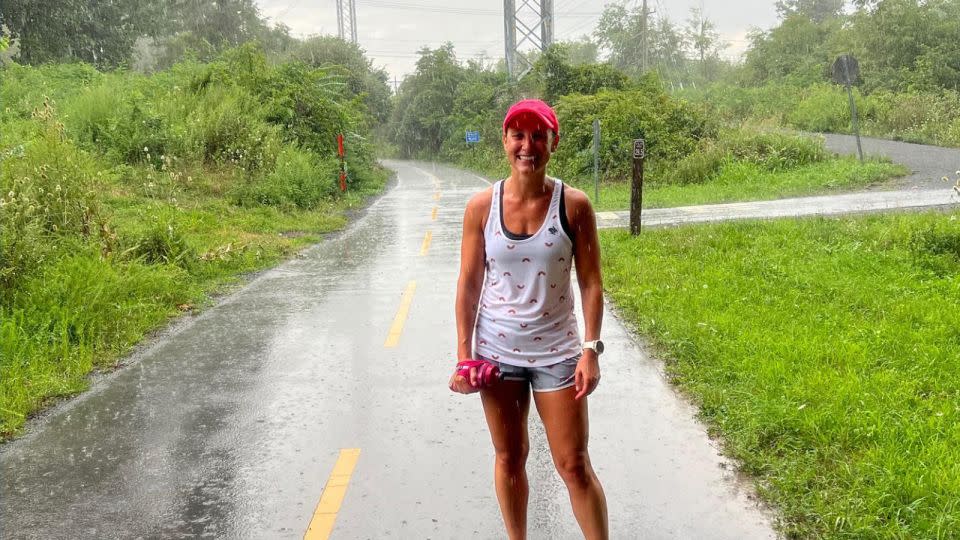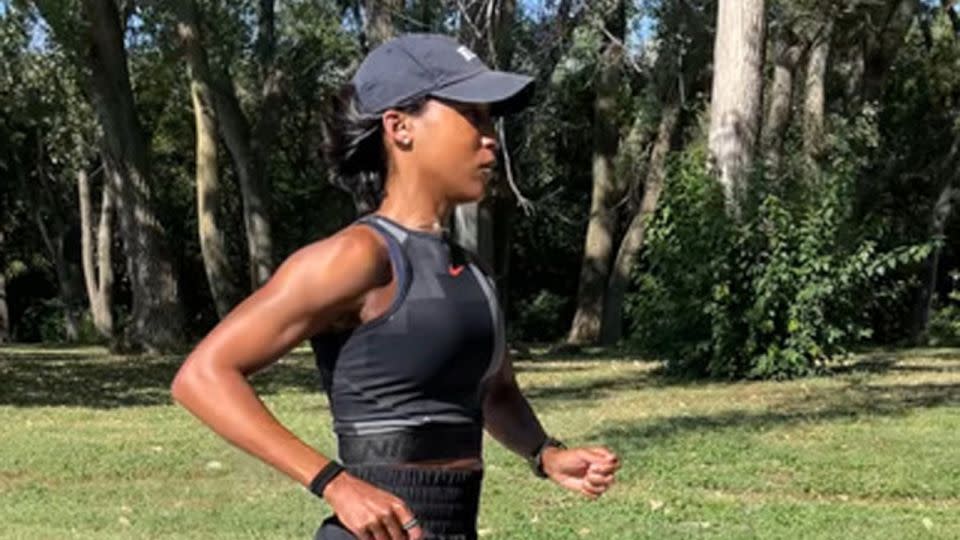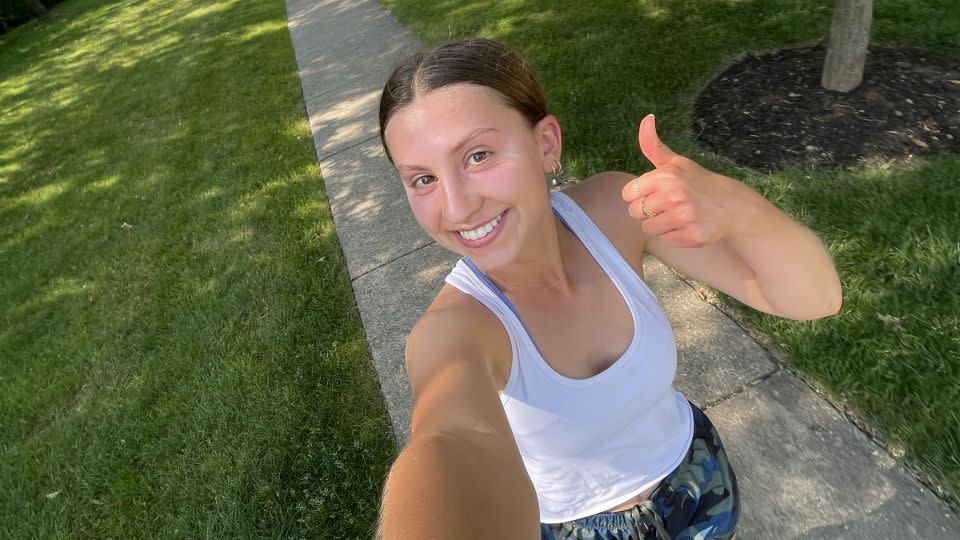Many women fear for their safety when running alone. Here’s how they prepare
Dorothy Beal switches up where and when she runs to avoid a pattern in case someone is watching her. She also waves at passing runners who appear friendly so that if she goes missing, someone may be able to pinpoint where she was last seen, she says.
Emily Scaglione doesn’t wear her hair in a ponytail while running because she fears it could give an attacker something to latch onto. And Veronica Amele avoids putting her hoodie over her head because she says it blocks her peripheral vision if someone’s approaching from behind.
Female runners have long endured catcalls and unwanted advances from men who sometimes follow them. But last month’s killing of student Laken Riley, who was attacked while jogging on a wooded trail in Athens, Georgia, has renewed safety fears among women who run alone.
Like the abduction and murder of Eliza Fletcher nearly two years ago in Tennessee or the killing of Molly Tibbetts in Iowa in 2018, the deadly attack on Riley is another reminder of the risks facing female runners, several women told CNN.
A survey by Adidas of runners in nine countries, including the US, last year revealed that 92% of women say they feel concerned for their safety when they go for a run. More than two-thirds of the women surveyed take specific safety precautions, including running alongside a friend or partner who can protect them.
“Any time I hear of another woman’s life senselessly taken while running, it’s a stark reminder that we are never entirely safe and that I must protect myself to the best of my abilities,” Beal says. “But I can be vigilant, even hypervigilant, and something could still happen to me. The responsibility should not be on women to prevent their own attacks.”
CNN talked to a handful of female runners across the US about their experiences and the safety measures they take.
She’s run 47 marathons. One incident with her kids changed everything
Dorothy Beal says she has been a runner for more than two decades and has completed 47 marathons. About 10 years ago, she says a man chased her while she was running with her three children in a triple stroller, changing her perspective on safety.
The man pursued her in a car and yelled obscenities at her as she pushed the stroller, her body in fight-or-flight mode, she says. It was the first time a stranger had hurled vulgar words at her while she was running, but not the last time, says Beal, a running coach who lives in Brambleton, Virginia.
Passing strangers in cars or bicycles also have commented about her body while she runs, she says. Because of these incidents, she’s added several safety measures.

“I vary when I run, where I run, and how far I run so that no one can establish a pattern of when I leave my house or where I’m going and for how long,” she says. “Having been chased down by someone in a car before and verbally assaulted on more than one occasion, I try always to be aware of my surroundings.”
Beal’s running route includes parks and wooded areas, and she always carries her phone — something she never did before the incidents, she says. If she’s listening to music, she makes sure the volume is low enough so she can hear a potential threat. She also avoids carrying pepper spray because she’s afraid someone could overpower her and use it against her, she says.
In the past, she woke up at 4 a.m. to run in the pre-dawn darkness. But not anymore. And if anyone makes her feel uncomfortable, she cuts her run short, changes her route or calls a friend to stay with her on the phone until she’s safe.
“Sadly, we live in a world where the time of day, what we wear, or what precautions we take when running don’t matter,” she says. “Things can still happen to us.”
She hides a personal alarm in her sports bra
Veronica Amele runs about three days a week and never leaves home without her pepper spray, a charged phone and a personal safety alarm stuffed in her sports bra.
Her family tracks her whereabouts with the Life360 location-sharing app when she runs. In 2022, she was training on a wooded trail and noticed a man who appeared to be following her. He stopped after she ran in the direction of someone walking their dog, she says.
Amele, a running coach in the Atlanta suburb of Kennesaw, says the killings of runners in the past few years have made her rethink her security — and the safety of the people she’s training.
She urges female runners to prioritize safety by notifying someone when they’re out running, changing their routes and start times, carrying a safety device and not wearing headphones. She’s become hypervigilant about her safety, she says, which has made her runs more like training sessions and not the decompressing breaks they once were.

Amele says she’s always on the alert, with her finger hovering over the nozzle of her pepper spray when someone approaches during a run.
“It’s hard to relax when you’re always looking over your shoulder,” she says. “If I see a guy coming toward me, I make sure the pepper spray is ready to go. And when he passes me, I turn around to make sure he’s still going his way and has not turned to follow me.”
Her alarm, a tiny gadget with a shrill whistle-like sound, is loud enough to scare off attackers and alert others nearby, she says.
She also changes her running schedule and locations to make sure her patterns are not predictable.
“Sometimes I’ll go back to a trail after training somewhere else and someone will tell me, ‘I haven’t seen you in a while, did you stop running?’ “Amele says. “It’s kinda creepy, because it tells you people are watching (you).”
She’s rethinking her early morning runs after Riley’s killing
Sarah Lyon runs about five times a week as part of her marathon training. The Chicago resident runs on a lakefront trail most mornings, a decision she made out of safety concerns.
“Cars can’t follow me on the trail, and there’s more space out there so I will be able to see someone coming from farther away,” says Lyon, who works in social media marketing.
Lyon says she sometimes gets unwanted catcalls when running on sidewalks, and carries pepper spray on a hand strap so it’s easy to access. She also notifies someone when she’s heading out for a run and tells them what time she’ll be back so they can alert authorities if she doesn’t return.

She never wears headphones on the trail, always alternates her routes and is on a constant lookout for potential danger. She says news of Riley’s killing, which occurred during her morning run, has made her rethink her start times.
“I prefer to run early in the morning because the city is quiet and peaceful and I love to watch the sunrise. However, over these last few days, I have definitely become even more aware of my surroundings when I’ve been out there,” she says.
“The quiet mornings aren’t peaceful to me right now. Instead, I see it as the perfect time for someone to get away with a crime because nobody would be around to see it.”
Lyon says the world puts a burden on women to protect themselves instead of putting more effort on preventing attacks.
“Society is not doing enough to teach men not to attack women,” she says. “There are far too many people who blame victims when something happens instead of holding the criminals accountable.”
She plays loud music when she’s running
Emily Scaglione, a student at Baylor University in Texas, runs about four days a week on trails in parks and wooded areas, she says. Most days, she makes sure her hair is in a french bun — not a ponytail — when she’s running, she says.
“Ponytails can be dangerous to run in, because it essentially provides a handle that trails behind you, therefore making you easier to grab,” she says.
She also runs with pepper spray strapped to her hand and blares music from her phone without headphones.

“I exclusively listen to my music out loud. Although many may see this as obnoxious, it makes me feel safest,” she says. “Not having anything in my ears allows me to be more aware of my surroundings and alerts people that I am coming up behind or around them.”
And if she got attacked or abducted, she says, her loud music might draw attention and help passersby notice.
She says she’s even taken photos of cars that appear to be following her so that if something bad were to happen, the license plate would provide a starting point for investigators.
Scaglione says taking all these measures can feel exhausting and infuriating. She also knows they may not count for much against a determined attacker.
“Riley seemingly did everything right; she ran while the sun was up, told people where she was going, and was even close to her college campus, yet it still wasn’t enough. This has just further proved to me that although my precautions are essential, it could not be enough,” she says.
Scaglione and the other women all say the recent killings have left them more on edge. But they’re determined to keep running.
For more CNN news and newsletters create an account at CNN.com

